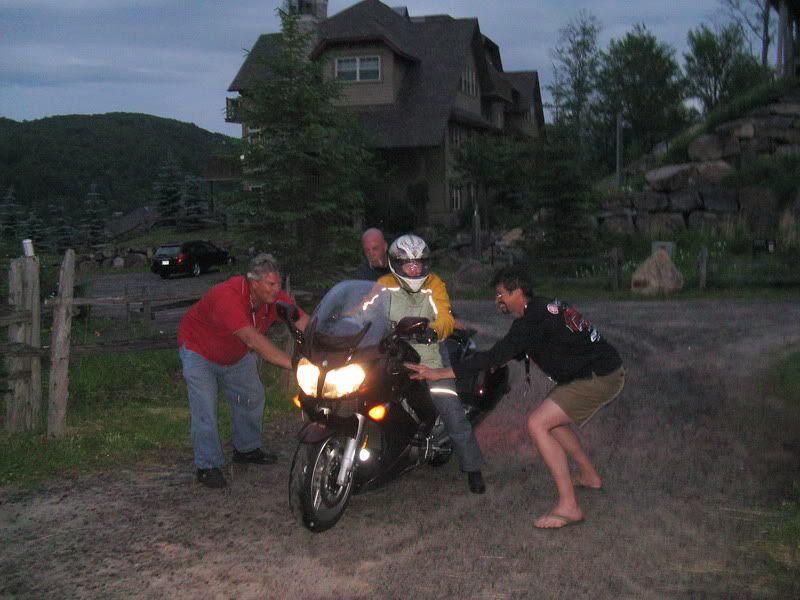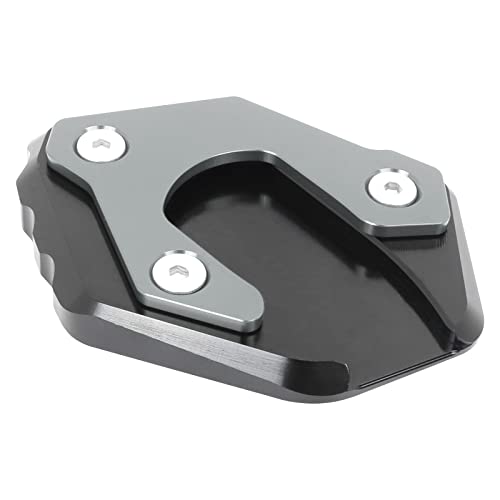Dennis in NH
Well-known member
Bottom line is the FJR is a great bike but a little tall for those of us on the short side. By "short", I include myself at 5'6" tall with 30" inseam. Many of us (self included) have either strongly considered or actually have lowered the FJR but this is not without its consequences -- if you lower the FJR, you have to compromise a little -- for example, handling is affected, leaning angle is reduced, ground clearance is reduced etc. I'm sure you can certainly live with these things but I think that I could not. Plus there are times when I want the clearance especially for more spirited riding and perhaps to get that oil pan under the bike, etc. If you do lower the bike, you have the benefit of perhaps being able to flat foot it -- which just feels safer and perhaps may instill more confidence.
For those of you who choose not to lower your FJR, here're a few tips I've come up with that have made my FJR riding experience more enjoyable and perhaps safer. I would like to hear from other short riders on their ideas I may not have covered.
Wear boots that allow you to add a little height -- I wear these workboots that give me about 1/2" of height. I have some gel insoles for comfort and that maybe gives 1/8". The brand is Magnum and I got them at Sports Authority for $65; I've gotten them for $50 in the past though.
Flat footing it is overrated. I came from a cruiser so flatfooting it was standard. It made me feel good to have all of my feet on the ground but the bike was heavy enough that even with flat footing it, I could not back up in some situations.
To back up your bike, it's ok to get off the bike and push or pull it into place. I do this at work where there's a nice concrete strip for kickstands -- it's raised a little so backing up onto it is a chore if I'm on the bike. Pulling the bike back while off of the bike makes it much easier. Just practice until you get the right angle and don't end up pulling the wrong way and just wasting energy.
At stop lights or stop signs or anyplace you need to stop, look at the road and see which side it's highest on. That's the side you will use to put your foot down. Most roads are "crowned" to allow drainage -- this means that they slope to one side. You want your down foot to be on that side. If it's about even, don't be afraid to try to get both feet down even to the point of sticking one out a bit to get balance. This is a heavy bike so think about balancing it and not muscling it. Sticking a foot farther out can help balance and stabilize you when you come to a stop. I will sometimes stop with both feet out and be stopped for a second or so before one foot comes down. Remember when that foot comes down, it's not because the bike is falling fast -- it's because you're trying the keep the bike balanced and upright. It's not about strength, but balance.
Embrace the front end dive. When you stop hard or moderately hard, the front end likes to dive. Well, you just lowered the bike maybe an inch if for a second or so. Use that inch to figure out where you want to put your foot and get the foot situated quickly (i.e., in time for the rebound). Learn to make quick stops and get that foot down quickly -- I practice this in a parking lot where I will do a slalom type run and then hard stop, put my foot down for a few seconds and then make a quick left or right turn.
Move your butt forward on the seat; this is where the seat is the most narrow and it's where you can get the most out of the given length of your legs. For us men, don't go too close and brake hard -- this will protect the family jewels.
Remove the plastic height adjustment bracket -- I think that gave me about 1/4" lowering. It doesn't seem like much but it's noticeable. I don't think you need it anyway; at least in my case case, I'm not going to raise the seat.
Practice and get good at super slow maneuvers -- this reduces the need to put your feet down. There are times at stop signs when there're no cars waiting to go where I'll come to almost a complete stop and then go -- all while keeping my feet on the pegs. I usually try to at least go slow enough that the GPS shows zero mph.
Stretch by letting your leg(s) hang to the side. Short legs means your legs don't feel so cramped while on the pegs and on your toes -- so folks with shorter legs may find the FJR more comfortable while riding. To stretch, you can simply get your foot off the peg and let the leg hang -- taller riders will drag feet but shorter folks will enjoy the stretch. I tend to let the leg hang and then flex to help circulation.
Don't buy too tall of a windshield. I thought taller is always better and there is no such thing as too tall because you can always lower the windshield while riding. This is not necessarily true because the windshield only goes so low. You want to be able to see over the windshield -- in my case, I like to see over it a lot in a lot of conditions -- so, don't get anything too tall. Also, it's nice to be able to get good amount of wind on your face/chest; if the windshield is too tall, you cannot get the wind even with the windshield all the way down.
If anyone has any other 'short rider' tips, I'd be interested in hearing them.
Leg stretching or elongation is not an option
Thanks,
Dennis
For those of you who choose not to lower your FJR, here're a few tips I've come up with that have made my FJR riding experience more enjoyable and perhaps safer. I would like to hear from other short riders on their ideas I may not have covered.
Wear boots that allow you to add a little height -- I wear these workboots that give me about 1/2" of height. I have some gel insoles for comfort and that maybe gives 1/8". The brand is Magnum and I got them at Sports Authority for $65; I've gotten them for $50 in the past though.
Flat footing it is overrated. I came from a cruiser so flatfooting it was standard. It made me feel good to have all of my feet on the ground but the bike was heavy enough that even with flat footing it, I could not back up in some situations.
To back up your bike, it's ok to get off the bike and push or pull it into place. I do this at work where there's a nice concrete strip for kickstands -- it's raised a little so backing up onto it is a chore if I'm on the bike. Pulling the bike back while off of the bike makes it much easier. Just practice until you get the right angle and don't end up pulling the wrong way and just wasting energy.
At stop lights or stop signs or anyplace you need to stop, look at the road and see which side it's highest on. That's the side you will use to put your foot down. Most roads are "crowned" to allow drainage -- this means that they slope to one side. You want your down foot to be on that side. If it's about even, don't be afraid to try to get both feet down even to the point of sticking one out a bit to get balance. This is a heavy bike so think about balancing it and not muscling it. Sticking a foot farther out can help balance and stabilize you when you come to a stop. I will sometimes stop with both feet out and be stopped for a second or so before one foot comes down. Remember when that foot comes down, it's not because the bike is falling fast -- it's because you're trying the keep the bike balanced and upright. It's not about strength, but balance.
Embrace the front end dive. When you stop hard or moderately hard, the front end likes to dive. Well, you just lowered the bike maybe an inch if for a second or so. Use that inch to figure out where you want to put your foot and get the foot situated quickly (i.e., in time for the rebound). Learn to make quick stops and get that foot down quickly -- I practice this in a parking lot where I will do a slalom type run and then hard stop, put my foot down for a few seconds and then make a quick left or right turn.
Move your butt forward on the seat; this is where the seat is the most narrow and it's where you can get the most out of the given length of your legs. For us men, don't go too close and brake hard -- this will protect the family jewels.
Remove the plastic height adjustment bracket -- I think that gave me about 1/4" lowering. It doesn't seem like much but it's noticeable. I don't think you need it anyway; at least in my case case, I'm not going to raise the seat.
Practice and get good at super slow maneuvers -- this reduces the need to put your feet down. There are times at stop signs when there're no cars waiting to go where I'll come to almost a complete stop and then go -- all while keeping my feet on the pegs. I usually try to at least go slow enough that the GPS shows zero mph.
Stretch by letting your leg(s) hang to the side. Short legs means your legs don't feel so cramped while on the pegs and on your toes -- so folks with shorter legs may find the FJR more comfortable while riding. To stretch, you can simply get your foot off the peg and let the leg hang -- taller riders will drag feet but shorter folks will enjoy the stretch. I tend to let the leg hang and then flex to help circulation.
Don't buy too tall of a windshield. I thought taller is always better and there is no such thing as too tall because you can always lower the windshield while riding. This is not necessarily true because the windshield only goes so low. You want to be able to see over the windshield -- in my case, I like to see over it a lot in a lot of conditions -- so, don't get anything too tall. Also, it's nice to be able to get good amount of wind on your face/chest; if the windshield is too tall, you cannot get the wind even with the windshield all the way down.
If anyone has any other 'short rider' tips, I'd be interested in hearing them.
Leg stretching or elongation is not an option
Thanks,
Dennis





















































